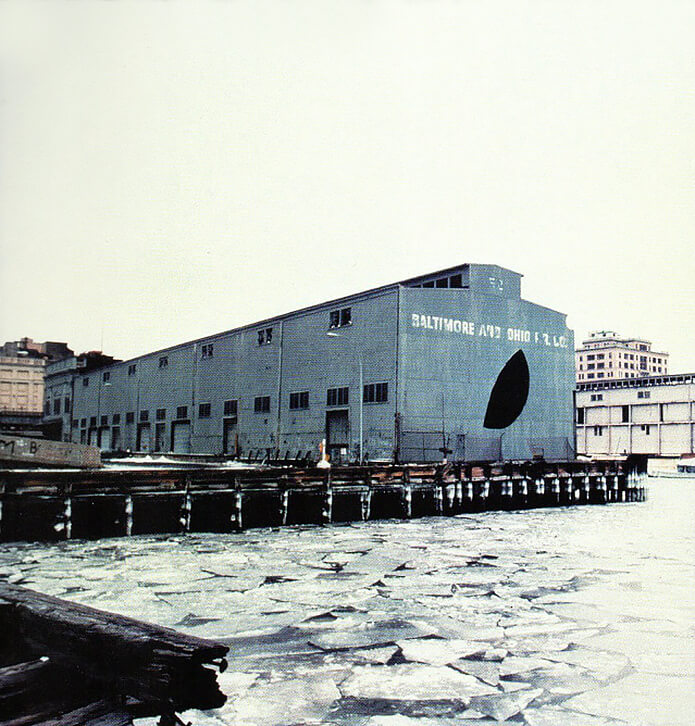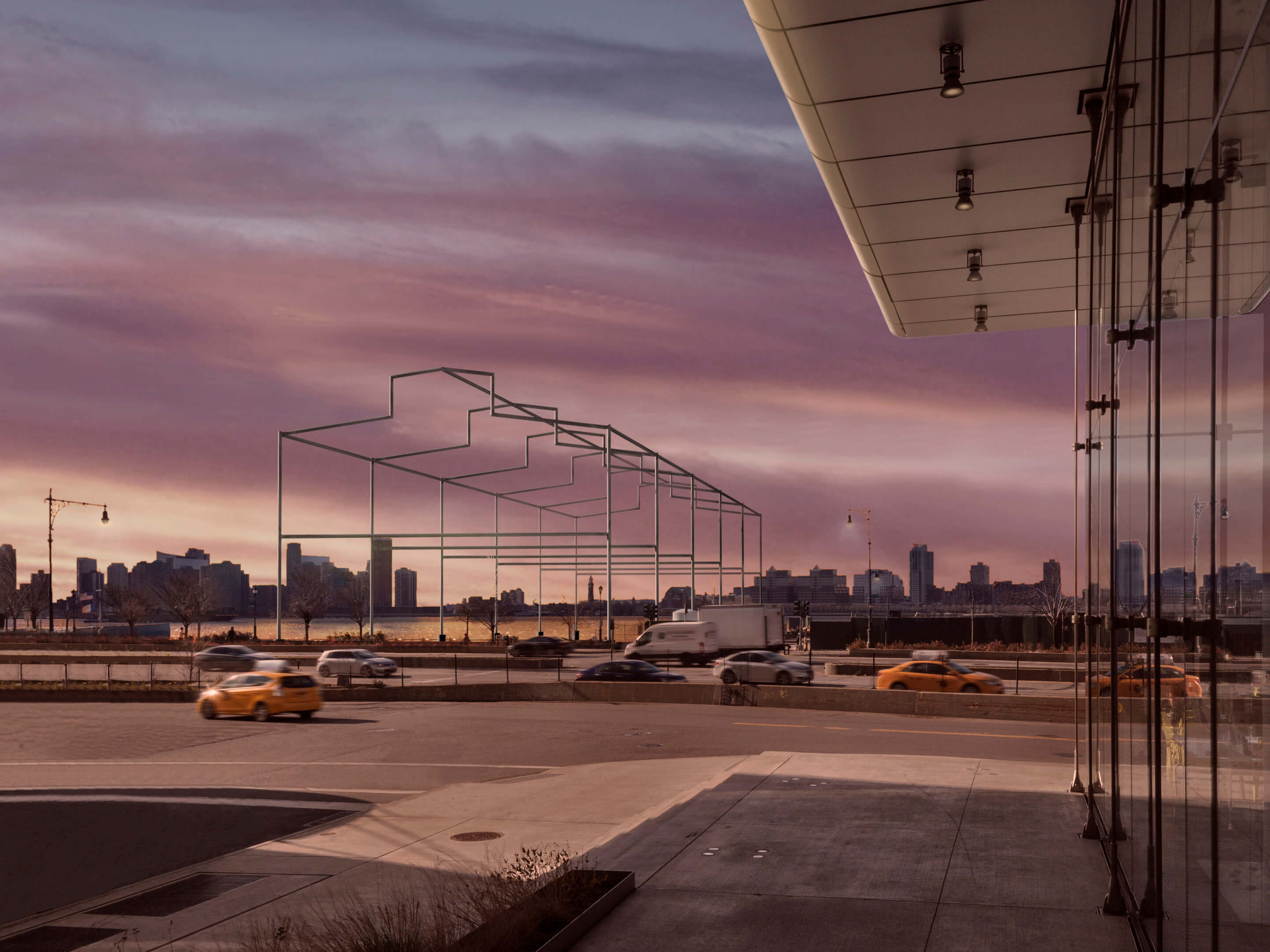When David Hammons’s Day’s End (2021) opened on the southern end of the Gansevoort Peninsula in New York’s Hudson River Park earlier this May, critics skirted the thornier questions surrounding its realization. Many were quick to commend Hammons’s daring, and they were not entirely wrong to do so. The 52-foot-high, 325-foot-long Super-Duplex steel sculpture, likely the largest permanent public artwork in New York City, required years of study to ensure its structural stability. In addition to withstanding river winds, the project had to shoulder the weight of historical baggage: 2021’s Day’s End reinterprets Gordon Matta-Clark’s canonical 1975 work of the same name. Then there was the price tag: $18 million.
Missing from notices in The New York Times and The Art Newspaper, however, was any mention of the piece’s ambivalent relationship to ownership and historical erasure. While this is perhaps due to limited space, another likely explanation is a general attitude that sees culture as an unmitigated good, a solvent for cleansing the wrongs of the past. Why slog through the origins of things when the present is so pleasant? Day’s End doesn’t disavow history as much as it selectively engages (and ignores) it.

The Gansevoort Peninsula was once home to Pier 52, a warehouse belonging to the Baltimore and Ohio Railroad Company before it was demolished in 1979. Built in the 1870s, the edifice had long outlived its usefulness by the time Matta-Clark made his signature cuts in its corrugated steel walls. Already by the early 1960s, New York’s ports were losing out to rival municipal ports, a fact owing to technical innovations in shipping and the city’s own economic decentralization. Realizing there was no turning back the clock, Mayor John Lindsay pushed to convert the Chelsea waterfront into a site of public recreation, though these efforts mostly came to naught. By the mid-1970s the crumbling Chelsea piers had become a meeting site for gay men living nearby in the West Village, imbuing the dilapidated area with a sense of liberation and community.
Matta-Clark created Day’s End over the course of two months in the summer of 1975. After “securing” the site from “S&M cruisers,” as he put it, the artist spent most of July and August carving five monumental voids into the building’s floor and walls; the position of these cuts was calibrated to the sun’s daily trajectory, with the surface of the river—visible through the cuts in the floor—acting as a reflective agent. Matta-Clark, who was initially drawn to the warehouse because of its “basilical light and proportions,” had transformed an anonymous cruising haven into a postmodern cathedral. Not everyone was appreciative of his efforts. An attempt to stage an “opening” for the work was quickly shut down by the Economic Development Administration, and Matta-Clark was later required to defend himself against the threat of litigation, which he did by claiming the work was a public monument to New York’s decay.
By contrast, Hammons’s Day’s End had the full backing of municipal and federal agencies, not to mention the Whitney Museum of Art, whose Renzo Piano-designed facility overlooks the Gansevoort Peninsula. Guy Nordenson and Associates provided structural expertise, advising that 150-foot steel piles be driven into the bedrock (where construction workers hit the remnants of the original wharf’s timbers) in order to secure the unwieldy artwork. Hammons desired that the steel tubes of the superstructure be as thin as possible—a request that proved especially challenging to the engineering team—and selected a matte-gray shade of steel to evoke a careful balance of solidity and delicate gleam. As built, the project bears an impressive resemblance to the single preliminary line drawing the artist submitted to the Whitney in 2014.

The stoic simplicity of Day’s End, so characteristic of Hammons’s sculptural practice, invites onlookers to read into it what they wish. But if critics obliged him, they largely circled the same pool of references—primarily Alvin Baltrop’s series of photographs documenting the cruising scene that Matta-Clark’s work temporarily displaced. Emily Colucci, in a review published on Filthy Dreams, ventured further afield, pointing to the work of photographers Shelley Seccombe and Frank Hallam, which captures a Pier 52 on the rebound. While Baltrop’s and Seccombe and Hallam’s works are certainly worthy of attention, we might consider another artistic intervention that perhaps better gets at the conceptual and historical implications of Hammons’s monument. The derelict buildings along Chelsea’s piers crop up in David Wojnarowicz’s photographic series Arthur Rimbaud in New York, which he shot from 1978 to 1979. In these pictures, the artist dons a photocopied Rimbaud mask and wields a pistol, striking various poses against walls of graffiti that he scrawled himself. Wojnarowicz, who was also a poet, took Rimbaud as a direct model, and so the photos constitute an anachronistic compounding of art and life. So too with Hammons’s Day’s End.
Notably, in the 1980s, Wojnarowicz was part of a group of mostly gay artists (many of whom, including Wojnarowicz, later fell victim to the AIDS epidemic) who took over the abandoned Pier 34 and transformed it into an art space. “We are all responsible for what it currently is and what it will become,” Wojnarowicz and fellow artist Mike Bidlo wrote in their statement for the inaugural show. “This is something possible anywhere there are abandoned buildings. This is something possible everywhere.”
It’s worth bearing in mind when we consider the ethics of Day’s End. Hammons has kept mum about his intentions, but even if we were to give him the benefit of the doubt, there’s no mistaking what his installation does: dissolve what was once a derelict cathedral of proscribed carnality down to skeletal remains. There is little in this that comments on the plutocratic takeover of New York’s waterfront and still less that addresses the homophobic implications of Matta-Clark’s inciting work.
Hammons’s Day’s End fares better, however, when viewed as an act of framing. If we take the steel tubing as boundary lines, rather than the focus of the work, Hammons’s primary medium is revealed to be time itself. The installation thus becomes a vessel through which to read and reevaluate the site’s history. Of course, a consideration of the work from this vantage necessitates a specific awareness of the conditions of the present. With time itself as the primary conceptual content, we may, for instance, consider yesterday’s dockworkers and cruisers as uncredited performers. Invoking this same spirit of generosity, the Whitney Museum has claimed that Hammons’s work is owned “by everyone and no one.” To think that any place in Manhattan could go without proprietary ownership is naive in the extreme. (That ship sailed in 1624.) Day’s End, like its neighbor Little Island, is pitched as a “gift” from the city’s wealthiest, for which we are expected to be grateful.
But Hammons’ deft obliqueness allows for a more backhanded reading. Looming over the waterfront like a headstone, Day’s End at once commemorates and forecloses on the possibilities spoken of by Wojnarowicz. The open-endedness it espouses, both materially and metaphorically, may be applied to the site’s past as well as its future, appearing, depending on one’s proximity, by turns ethereal and ossified.
Kathleen Langjahr is a writer and researcher living in Brooklyn, New York.











